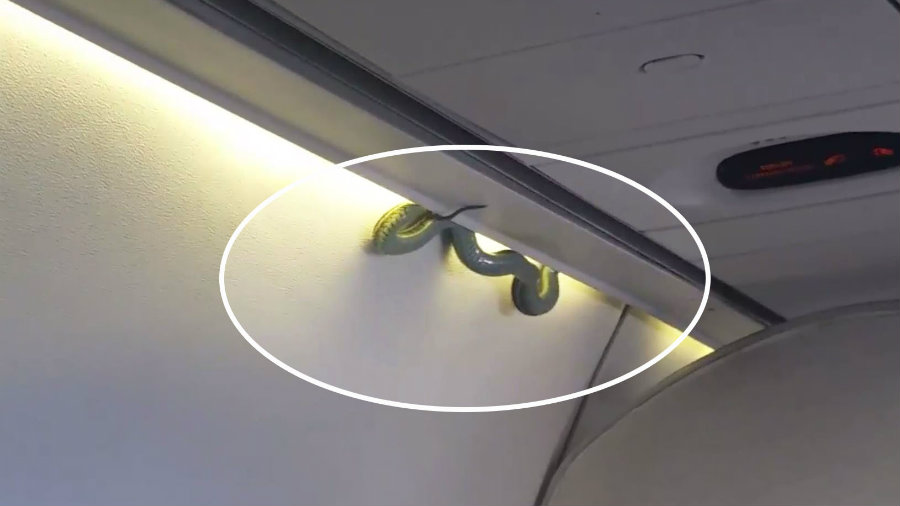Samuel L. Jackson was needed Sunday on an Aeromexico flight, which was given a priority landing in Mexico City when a venomous snake appeared on a plane from Torreon. Members of the city’s animal control department came aboard the aircraft to remove the green viper.
Indalecio Medina, a passenger on Flight 231, posted a video to Twitter showing the reptile as it was slowly descending from an overhead luggage bin. The snake suddenly fell onto some seats and kept dangling from the plane’s ceiling.


Medina described the moment as a “unique experience.” He said he gave the green viper “some magazines to read” after he captured it in a blanket. Well, it seems like the snake didn’t really cause terror as one might expect from a real-life incident resembling the 2006 movie Snakes on a Plane.
The airline said in a statement that it did not know how the snake ended up in the cabin.
“The procedures carried out for this flight are currently being evaluated to determine how the animal entered the cabin and measures have been taken to avoid such incidents in the future,” Aeromexico told CNN.
Snakes don’t usually get on planes by themselves
In 2009, four pythons escaped from their container in the hold of a plane. The story reported by the Daily Mail at the time clearly indicates that these reptiles had been taken to the aircraft by humans. No-one on the Qantas flight from Alice Springs to Melbourne was aware that there were pythons on the loose on that Boeing 737-800.
Fortunately, it was not until the plane landed that freight handlers noticed the snakes had escaped from the container. Two flights had to be canceled because the airline called for every worker to take part in the extensive search. Pythons, which can grow up to three feet long, were nowhere to be found.
A Qantas spokesman said they all agreed that fumigation was the best choice because that would ensure the snakes would not cause problems on future flights. They could have taken the aircraft apart to continue searching for the snakes, but the pythons were excellent at hiding.
“You can just imagine the scene on board if someone looked down and saw a snake slithering around their feet – and then someone else saw another,” said a Qantas passenger, as quoted by the Daily Mail. “There would be absolute mayhem.”
More recently, a Texas snake expert smuggled 7 Peruvian snakes into the United States in 2013, according to a report by NBC News. William Lamar, a then 63-year-old eco-tourism guide, purchased the snakes at a market in Lima, Peru, put them in plastic cases and flew with them in his jacket to Miami and then to Dallas, Fort Worth International Airport, where he was caught by a Transportation Security Administration officer. Lamar was trying to board a commuter flight to Tyler.
The U.S. Attorney’s Office said at the time that the snakes were about six inches long, but five of them were venomous, including three Bothrops barnetti and two Bothrops pictus. These were pit vipers, and the other two reptiles were an Oxyrhopus fitzingeri and Pseudalsophis elegans.
Lamar pleaded guilty in federal court in June 2013, as he said he knew he had done something illegal. U.S. Attorney John M. Bales announced he was sentenced for violating a foreign law by smuggling live snakes into the Eastern District of Texas, according to the Department of Justice’s website. In October, the snake expert was sentenced to three years of probation by U.S. District Judge Michael H. Schneider.
A representative told NBC News that Lamar was a partial owner of Colorado-based ecotourism company Green Tracks. A spokesperson for the University of Texas at Tyler told NBC News in 2013 that Lamar had been an adjunct professor, while the company website stated that he conducted research on reptiles and amphibians for the university.
The eco-tourism guide has written at least three books on reptiles and has spent decades doing research in the Amazon, as well as leading tours in the region. He has also been a speaker at an event for the Austin Herpetological Society, according to the report by NBC News.
Source: CNN
